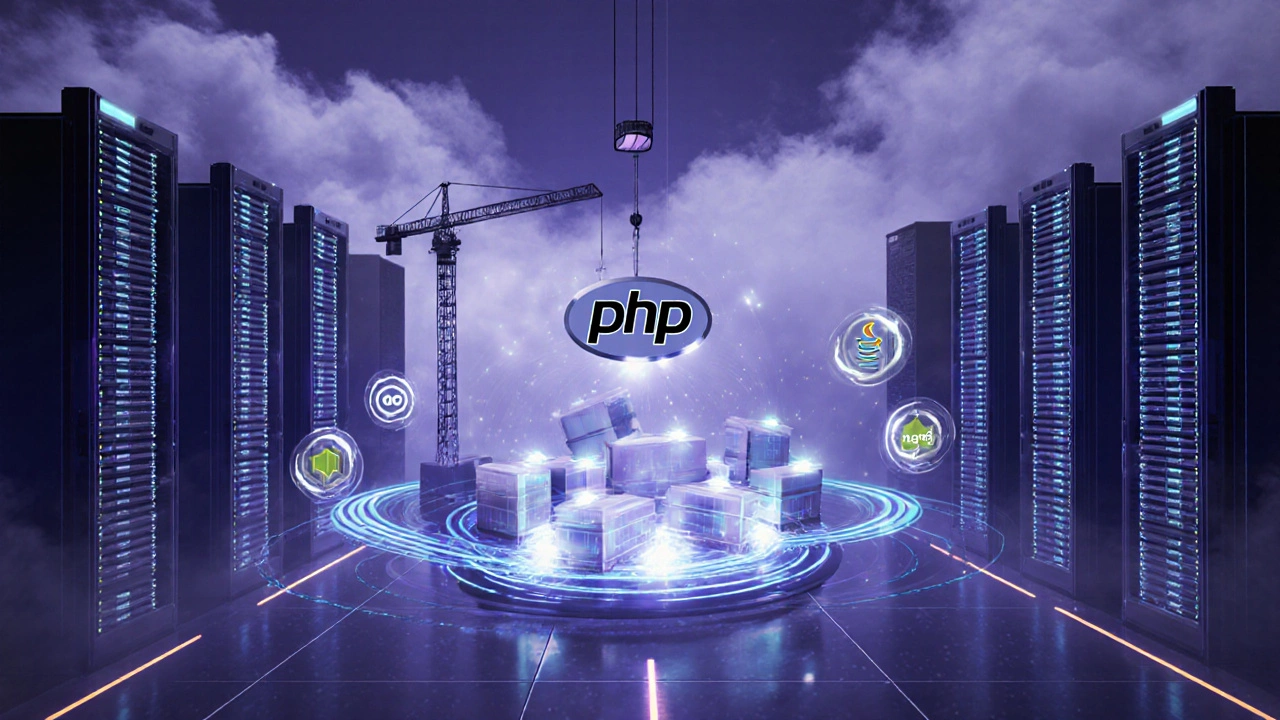Enterprise Language Selection Tool
Select Your Project Requirements
When you hear PHP is a server‑side scripting language that powers about 78% of the web, you might wonder why the world’s biggest tech firms often skip it. The short answer is that large organizations weigh performance, security, talent availability, and ecosystem maturity differently than a hobbyist or small agency. Below we unpack the seven most common reasons why enterprises gravitate toward other stacks.
1. Performance and Scalability Limits
Historically, PHP executed code in a shared‑nothing model, meaning every request started a fresh interpreter. This design kept shared‑hosting cheap but added latency for high‑traffic sites. While PHP 8 introduced JIT compilation and improved type handling, the language still lags behind Java and Node.js in raw throughput for micro‑service architectures.
Enterprises that need to process millions of transactions per second often choose languages that compile to native code or run on highly‑optimized runtimes. The result is lower CPU usage, better thread management, and finer‑grained scaling with containers.
2. Type Safety and Maintainability
Large codebases demand strict contracts to avoid costly bugs. Early PHP versions were dynamically typed, which made refactoring a nightmare. Although PHP 7 added scalar type declarations and PHP 8 brought union types, the language still feels loose compared to C#/.NET or Java. Those ecosystems ship with built‑in static analysis tools, mature IDE support, and long‑standing conventions that keep large teams on the same page.
3. Security Perception and Track Record
Because PHP was originally designed for quick web page scripting, many early tutorials ignored best‑practice security patterns. The resulting legacy code is riddled with SQL injection, XSS, and CSRF pitfalls. Even though modern frameworks like Laravel bake in CSRF tokens and prepared statements, the stigma sticks. Enterprises often prefer languages whose default libraries enforce stricter security sandboxes, such as Python with its built‑in SSL support or Go with its emphasis on concurrency safety.
4. Ecosystem and Tooling Maturity
When a company evaluates a tech stack, it looks at the surrounding ecosystem: monitoring, logging, tracing, and CI/CD integrations. The Java and .NET worlds have decades‑long tooling ecosystems-think Spring Boot, Microsoft Azure DevOps, and enterprise‑grade APM solutions. PHP’s tooling, while improving, still feels fragmented. Composer, the dependency manager, is solid, but the variety of frameworks (Symfony, Yii, CodeIgniter) means teams must standardize internally, adding overhead.

5. Talent Pool and Hiring Costs
Enterprise recruiters report that senior engineers proficient in Java, C#, or Go command higher salaries, but they are also more plentiful in large market hubs than senior PHP developers. The perception that PHP is “for freelancers and WordPress sites” narrows the talent pool, making it harder for big firms to staff critical projects without compromising on experience.
6. Cloud‑Native and Serverless Compatibility
Modern infrastructure prefers languages that are lightweight, start quickly, and integrate seamlessly with containers or serverless platforms. While you can run PHP in Docker, the image size and cold‑start times are typically larger than a Go binary or a Node.js bundle. Companies like Google Cloud Functions and Amazon Lambda list supported runtimes prominently, and PHP is often an afterthought.
7. Legacy Legacy and Migration Cost
Many large enterprises inherited monolithic systems built on older PHP versions (5.x). Migrating to a newer language isn’t just a code rewrite; it requires re‑architecting databases, CI pipelines, and monitoring dashboards. The cost of migration can outweigh the perceived benefits, especially when the existing system is stable and the business isn’t chasing new market segments.
Comparison Table: PHP vs Popular Enterprise Languages
| Language | Performance | Type Safety | Enterprise Ecosystem | Talent Availability |
|---|---|---|---|---|
| PHP | Good for typical web workloads; slower for CPU‑intensive tasks | Gradual typing; improving but still optional | Strong in CMS & e‑commerce; fragmented in micro‑services | Abundant for junior roles, scarce for senior architects |
| Java | High performance on JVM; excellent concurrency | Static typing enforced by compiler | Mature frameworks (Spring, Jakarta EE), robust APMs | Large global pool, higher salary expectations |
| Python | Moderate; suitable for data‑heavy workloads | Dynamic but typing hints increasingly common | Strong in AI/ML, growing in web (FastAPI, Django) | Widely taught, many mid‑level developers |
| Node.js | Fast I/O, event‑driven; good for real‑time apps | Dynamic, but TypeScript adds static typing | Rich npm ecosystem, cloud‑native tooling | High demand, especially in startups |
| C#/.NET | Excellent on Windows/Linux containers | Strong static typing, nullable reference types | Deep Azure integration, mature enterprise libraries | Strong in enterprise hubs, competitive salaries |

Checklist: When to Consider PHP for an Enterprise Project
- Project revolves around a CMS or e‑commerce platform where existing plugins are PHP‑based (e.g., Magento, WordPress).
- Team already has senior PHP engineers familiar with modern features (typed properties, JIT).
- Performance requirements stay within typical request‑response cycles (< 200 ms).
- Security can be enforced via framework conventions (Laravel, Symfony) and regular code audits.
- Budget constraints favor open‑source tooling over costly commercial licenses.
Real‑World Examples
Facebook started with PHP, then created Hack, a PHP‑derived language that adds static typing. The move illustrates how a giant can evolve away from vanilla PHP while still leveraging its ecosystem.
Twitter famously migrated many services from Ruby on Rails to Java and Scala for scalability, while still keeping a small PHP team for legacy marketing pages.
On the flip side, Shopify and WordPress.com continue to invest heavily in PHP because their core products depend on it, and they have built massive, efficient infrastructure around the language.
Future Outlook for PHP in the Enterprise
PHP 8.3, slated for late 2025, promises further JIT optimizations and union‑type refinements. Combined with the rise of Flywheel (a serverless platform built for PHP), the gap is narrowing. However, the perception challenge remains: many CIOs still associate PHP with “small‑business websites”. Overcoming that bias will require case studies, demonstrable performance benchmarks, and clear migration paths.
Bottom Line
Big companies don’t avoid PHP because it’s inherently bad; they avoid it because other languages align better with their priorities around speed, type safety, talent, and cloud‑native ops. When the project’s core needs match PHP’s strengths-rapid development, rich CMS ecosystems, and low licensing costs-using PHP can still be a smart choice.
Is PHP still a viable option for new enterprise applications?
Yes, if the application leans heavily on content management, e‑commerce, or needs rapid prototyping. Modern PHP versions add typing, JIT, and robust frameworks that address many traditional concerns. The key is to pair PHP with a solid CI/CD pipeline and enforce strict coding standards.
What are the main performance drawbacks of PHP compared to Java?
Java runs on a highly optimized JVM with just‑in‑time compilation that can exceed several million requests per second on modest hardware. PHP, even with its own JIT, still incurs a higher per‑request overhead because each request spawns a new interpreter context unless using a long‑running server like Swoole.
How does the talent market differ for PHP versus Node.js?
Node.js developers often come from a JavaScript background, making the pool larger and more uniformly skilled in front‑end and back‑end work. Senior PHP engineers are fewer, and many focus on legacy codebases. This gap can increase hiring time and salary expectations for PHP senior roles.
Can existing PHP codebases be moved to serverless architectures?
Yes, platforms like AWS Lambda now support custom runtimes, and third‑party services such as Bref or Flywheel enable PHP functions. However, cold‑start latency and package size can be higher than with native Node.js or Go runtimes.
What security measures should a PHP team adopt for enterprise use?
Adopt a modern framework (Laravel, Symfony) that enforces CSRF tokens, prepared statements, and input validation out of the box. Pair with static analysis tools like Psalm or PHPStan, and enforce code reviews that focus on OWASP Top 10 risks.
